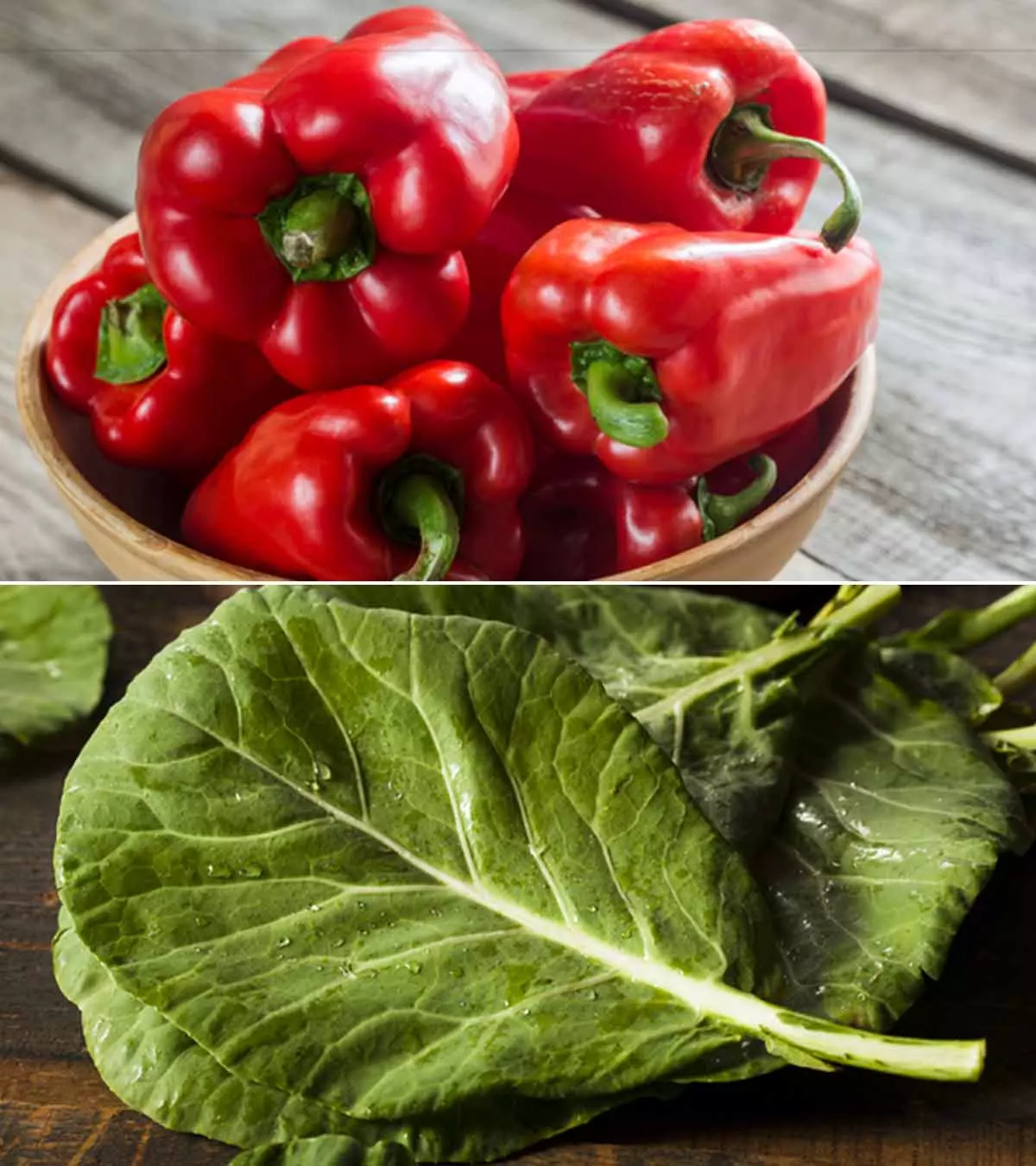

Image: Shutterstock
Pregnant women need to be careful about their nutrition and diet. So, if you are looking for ideas, here are some healthy foods to eat when pregnant that you can try out. It is a common myth that mothers have to eat for two during pregnancy. But, while the quantity is not important, mothers need to eat the right food to gain weight at a healthy pace. Moreover, morning sickness and nausea may make it difficult for pregnant women to eat certain foods. So, read this post to know more about the food to eat and avoid during the first trimester of pregnancy.
Healthy Foods For Your First Trimester
You require all the essential vitamins and minerals from a varied diet in the first trimester. Folate, vitamin A, and beta-carotene are essential in the early stage of fetal development. So, here is the list of foods you can incorporate into your diet in the first trimester.
1. Spinach
Why it works:
Spinach is rich in folate, which helps prevent neural tube defects such as spina bifida in the baby. Folate helps your baby’s neural tube to fuse correctly in the first month of conception (1). Spinach is also high in fiber, iron, vitamins A, C, E, and K, and manganese (2).
Tips to take it in your diet: You can add a handful of spinach in scrambled eggs, or combine it with any other vegetables in soups, stews, or curries. Eat it raw by adding it to smoothies or salads.
2. Lentils (pulses)
Why they work:
They are a great source of protein and fiber that help in the development of the baby’s muscle and tissue (3). Fiber help in treating constipation, which is common in the first trimester. Make sure you stay hydrated when increasing your fiber intake.
Tips to take them in your diet: Lentil soup is a simple way to consume them. You can also add them to salads, ground meat, burgers, and more.
3. Citrus fruit
Why it works:
Citrus fruits such as lemon, oranges, limes, kiwifruit, and grapefruit are rich in folic acid too, which is helpful in baby’s neural tube development (4).
Tips to take them in your diet: Eat oranges and grapefruits whole or make fresh juices. You can infuse water with citrus juice to stay hydrated. Try a simple citrus marinade on mushrooms or other proteins and roast, bake, or grill it.
4. Cottage cheese
Why it works:
Cottage cheese provides calcium and protein needed for bone and muscle development of the baby (5).
Tips to take it in your diet: Top it with fruit, mix in smoothies, or spread it on bread or toast.
5. Nuts
Why they work:
Nuts are an excellent source of protein and beneficial fats needed for the baby’s growth and development. Walnuts, almonds, cashews, and pistachios have a good amount of protein, healthy fats and fiber (6).
Tips to take them in your diet: You can have a few of them at any time of the day. Sprinkle them on any hot or cold cereal, yogurt or ice cream.
6. Eggs
Why they work:
Eggs are an excellent source of protein, calcium, and vitamin D, all of which are essential for bone and muscle development in the baby. Choline present in egg yolk plays a vital role in fetal brain development (7). Soybeans are an alternative source for vegans.
Tips to take them in your diet: Have hard-boiled eggs, scrambled eggs, egg bakes, or omelet for breakfast. You can also add diced, boiled or sliced eggs to a salad or as a sandwich stuffing.
7. Yogurt:
Why it works:
Yogurt is rich in calcium and vitamin D, which are required for bone development in the baby (8).
Tips to take it in your diet: Top plain unsweetened yogurt with it fresh, diced fruit or add to a smoothie. Mix with chocolate chips and freeze it for a sweet treat. Use it as a salad dressing.
8. Broccoli
Why it works:
Rich in iron and folate, it is highly required for the formation of red blood cells and neural tube development (9).
Tips to take it in your diet: You can add it to salads, smoothies, and soups. For a different spin, you can also add to quinoa, grill on barbecue or eat raw.
9. Asparagus
Why it works:
Asparagus is rich in folic acid that helps prevent birth defects of the fetal brain and spinal cord (10).
Tips to take it in your diet: Like spinach, it can be diced and tossed with scrambled eggs, added to salad, soups, omelet, pasta, and stir-fries. Drizzle it with oil and salt and grill.
10. Collard greens
Why it works:
An excellent source of iron, which is essential during pregnancy for making red blood cells (11).
Tips to take it in your diet: Dice and add collard to salads, sandwich stuffing and wraps, or soups and casseroles. Blanch the leaves and use them as a “wrap” instead of the traditional wheat/flour based wraps.
11. Chicken
Why it works:
Chicken contains iron, which helps in making red blood cells, thereby providing both the mom and baby with sufficient oxygen supply (12).
Tips to take it in your diet: Marinate and grill chicken and add it to casseroles, salads, sandwiches, soups and stews. Ground chicken works great in tacos or pasta sauces..
12. Salmon
Why it works:
Salmon is rich in calcium and vitamin D (13).
Tips to take it in your diet: Do not consume raw or partially cooked seafood when pregnant. Season and grill a salmon filet and serve it with vegetables is classic. Top your salad or pasta for a protein punch.
13. Lean beef
Why it works:
Beef is a rich source of iron which helps in the production of red blood cells, thus supplying enough oxygen to the mother and the baby (14). Grass-fed, hormone-free and organic are the best choices.
Tips to take it in your diet: Can be formed into burgers, loafs, or meatballs. Use ground meat to add to salads, pizza and pasta. Toss with scrambled eggs and vegetables to make a lunch or dinner dish. Cook your ground beef to at least 160F/ 71C.
14. Bananas
Why it works:
They are a rich source of vitamin B6 that helps curb morning sickness and nausea you experience during early pregnancy. They also contain fiber, potassium, and vitamin C (15).
Tips to take it in your diet: Eat it whole, slice it over yogurt, or freeze it and add to smoothies in place of ice.
15. Red bell peppers
Why it works:
Vitamin C in red bell peppers is two times more than that in green bell peppers. The vitamin helps in iron absorption and is responsible for tissue growth and repair (16).
Tips to take them in your diet: You can add them to stir fries, sandwiches, burgers, salads. Casseroles and stuffed peppers with rice are other ideal options.
16. Avocados
Why they work:
Avocados are nutrient-rich fruits with high levels of folate, fiber, protein, and antioxidants. They contain monosaturated fats that protect against heart ailments. They are also known to curb morning sickness and assist in the fetal brain and tissue development (17).
Tips to take them in your diet: Bake it along with egg, sandwich or toast filling, dip, salad dressing, and salsa.
Foods To Avoid During The First Trimester
Here are some foods that should be avoided during the first trimester (18).
- Mercury-containing fish such as king mackerel, shark, and swordfish
- Undercooked or raw eggs and shellfish
- Unpasteurized milk
- Soft cheeses including feta, brie, and blue cheese
- Raw sprouts
- Unwashed fruits and vegetables
- Papaya, pineapple, black grapes
- Caffeine in excess
- Excess sugary foods such as sweetened beverages and desserts
To make it easier for you, we have also included a diet chart you can follow in the first trimester.
Sample Diet Chart For First Trimester
You should look for the right balance of vitamins, minerals, and nutrients throughout your pregnancy, especially in your first trimester.
According to the US Department of Agriculture (USDA) and the 2010 Dietary Guidelines for Americans, food is simplified into five major groups. Here is a simple diet chart for you: (19).
| Food group | Serving per day | Type | One serving of each food type equals |
|---|---|---|---|
| Fruits | 2 to 4 | Fresh, canned, frozen, juices and include at least one citrus fruit |
|
| Vegetables | 3 to 5 | Raw or cooked |
|
| Dairy | 3 to 4 | Milk, cheese, yogurt and soy milk |
|
| Protein | 2 to 3 | Meat, lentils, beans, poultry, fish, nuts and seeds |
|
| Whole grains | 6 to 11 | Whole grain flour, bread, crackers and cereals |
|
This list is just a starting point for your first trimester, and you should alter it according to dietary beliefs, allergens, sensitivities, and doctor recommendations. Don’t forget to take your prenatal vitamins.
It is essential to know the list of healthy and safe foods to eat when pregnant to avoid any complications. This may help you plan a diet for pregnancy. A balanced diet is necessary for the proper growth and development of the baby and healthy pregnancy. Spinach, lentils, poultry, nuts, lean beef, fruits, and vegetables are greater sources of nutrition. In addition, you may consume seafood and fish to get omega-3 fatty acids. However, limit the fish serving as per recommendation due to its mercury content. Taking prescribed prenatal vitamins and iron supplements is also necessary, even if you follow a well-balanced diet.
References
- Folate- Fact Sheet for Health Professionals.
https://ods.od.nih.gov/factsheets/Folate-HealthProfessional/ - Dark Green Leafy Vegetables.
https://www.ars.usda.gov/plains-area/gfnd/gfhnrc/docs/news-2013/dark-green-leafy-vegetables/ - Richard I. Lowensohn et al.; (2016); Current Concepts of Maternal Nutrition.
https://www.ncbi.nlm.nih.gov/pmc/articles/PMC4949006/ - James A Greenberg et al.; (2011); Folic Acid Supplementation and Pregnancy: More Than Just Neural Tube Defect Prevention.
https://www.ncbi.nlm.nih.gov/pmc/articles/PMC3218540/ - Nutrition during pregnancy.
https://www.canr.msu.edu/uploads/resources/pdfs/Nutrition_for_Adults_Life-Nutrition_During_Pregnancy_(WO1012).pdf - 5 nutrients you need during pregnancy.
https://source.colostate.edu/5-nutrients-need-pregnancy/ - Micronutrient Needs During Pregnancy and Lactation.
https://lpi.oregonstate.edu/mic/life-stages/pregnancy-lactation - 5 Snack Foods to Eat While Pregnant.
https://www.hopkinsmedicine.org/health/wellness-and-prevention/5-snack-foods-to-eat-while-pregnant - Nutritional Needs During Pregnancy and Breastfeeding.
https://ohioline.osu.edu/factsheet/HYG-5573 - Folic Acid Helps Prevent Serious Birth Defects of the Brain and Spine.
https://www.cdc.gov/ncbddd/folicacid/features/folic-acid-helps-prevent-some-birth-defects.html - 3 POWER FOODS THAT WILL CHANGE THE WAY YOU EAT DURING PREGNANCY.
https://sustainablefoodcenter.org/3-fall-foods-to-nourish-you-and-your-baby/ - Lesson Plan: Iron in a Pregnancy Diet.
https://sites.psu.edu/delpercionutr360/lesson-plan-iron-in-a-pregnancy-diet/ - Calcium and Vitamin D.
https://food.unl.edu/documents/calcium_and_vitamin_d_3.pdf - Should Women Eat Red Meat During Pregnancy?
https://www.pbmchealth.org/news-events/blog/should-women-eat-red-meat-during-pregnancy - Benefits of vitamin B6.
https://goaskalice.columbia.edu/answered-questions/benefits-vitamin-b6 - Prenatal Nutrition-Preparing Your Baby for Lifelong Health.
https://med.umich.edu/hits-redirect.html?url=https://www.uofmhealth.org/conditions-treatments/nutrition-services/food-and-nutrition-while-hospital/_pdf/hetm-2016/0416-prenatalnutrition.pdf - Avocado seen as a super fruit.
https://universe.byu.edu/2013/10/31/avocado-a-super-fruit/ - People at Risk: Pregnant Women.
https://www.foodsafety.gov/people-at-risk/pregnant-women - Pregnancy Planner.
https://www.womenandinfants.org/services/pregnancy/pregnancy-planner
Community Experiences
Join the conversation and become a part of our nurturing community! Share your stories, experiences, and insights to connect with fellow parents.
Read full bio of Amy Lucas
Read full bio of Swati Patwal














